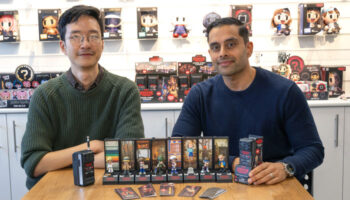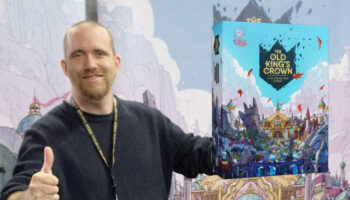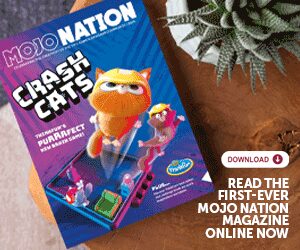Industry consultant Chris Isitt on fan culture, dress-up struggles – and what toycos should consider when evaluating a brand

Chris, you have worked at the ‘intersection’ of the licensing, toys and games industries for a number of years. Why do you think these industry sectors are so intertwined and dependent on each other?
Enhancing an existing successful product or category with a license can clearly elevate it to a new level. Similarly, a license can over-achieve against expectations when allied to product line that performs well. In theory, it’s a win-win which can work with both long term ‘heritage’ content, as well as shorter term fashion led trends. Businesses that are able to embrace both ends of the spectrum are probably better placed to spread the risk.
The relationship has built over 30 years of blockbuster movies and, more recently, great TV content which have engaged audiences and inspired consumer product sales. The wall to wall content from both manufacturers and licensors that is now available to audiences of all ages exposes them to a wide range of purchasing choice – combining both a toy, collectable or game they like with a favourite IP.
In recent years, global toy brands like Mattel and Hasbro have succeeded in bringing their brands ‘alive’ in licensing and entertainment. What lessons do you think other toycos can take from this?
Content is clearly king. The multitude of options available for consumers to interact with an IP has never been greater. A brand with good appeal should succeed if it’s widely visible across multiple formats, with social media and influencer support.
Budget is obviously a major consideration, but those global brands have managed to hot multiple platforms with their properties, even though the blockbuster movie that dominated consumer product sales 20 years ago is no longer the be all and end all to generating success. Tying a toy line – albeit a toy line that has some relative reputation and presence – onto platforms that have good consumer traction should be a good format for ensuring longevity and maintaining focus on the property
Switching focus for a moment, what advice would you give to a toy company considering taking on a license for the first time?
Your line needs to relate to the license. No good looking to just slap a badge on a product if it has no connection to the IP. We’ve all seen examples of over-licensing where hundreds of separate licenses lead to significant issues of inventory at retail when the license slows down. But, a great IP doesn’t always guarantee a successful licensed product, and conversely some of the most successful products in a category can be driven by IP that isn’t necessarily a tier one license.
The most important advice is to have an exit plan. All the positives of winning a license, developing fantastic product and getting the listings can be ruined by loss of focus and poor inventory management towards the end of the contract if the IP is in decline and you are not renewing. Check the listings at your nearest clearance specialist if you are in any doubt about this.
Are there any recent licensing deals you have seen in toys – or indeed other sectors – that you think are noteworthy and are good examples of licensing?
The creativity of LEGO is always remarkable, continually expanding the boundaries of the simplest play pattern and finding ways to relate the product to major licensing powerhouses. There is no better example of good licensing than huge, consistent levels of revenue!
What’s your take on retail’s approach to licensed products at the moment? Is there a ‘right way’ to sell licensed products into retail?
I’m not sure there is a ‘right way’. The main issues from retail around the most sought after product are usually price and availability. Sometimes there is a level playing field, but often there isn’t. The licensee needs to make the choice what its priorities are – a staggered launch with limited exclusivity if there are key retail relationships to protect, a rollout across all retail sectors to maximise availability, maybe an online only offer if timing and distribution logistics are an issue… Sometimes the timing of a launch has to be rushed to capitalise on a hot property at peak selling season. Sometimes the sheer volume of demand for must have product makes it difficult to meet the needs of the market – like Tracy Island or Teletubbies if you’re as old as me!
There has been a lot of talk about rights owners and licensees tapping into the fan community in recent times. Do you think we have a better appreciation of fan culture now?
The buzzwords on our licensing bingo cards over many years of showcases in Vegas and BLE have moved on from ‘overarching’, ‘phenomenon’ and ‘zeitgeist’ to include ‘faniverse’ and ‘fanisphere’. Licensors are very aware of the fan community and how its demographic and disposable income can add new revenue streams. Interesting though that some retailers have been doing this successfully for 40 years! With more licensees looking at this market, the upside for fans is that more product will become available.
You have had a wide ranging career in the toys sector which has included a number of years working in the dress up sector. Can you give us a ‘state of the nation’ summary of that sector at the moment and how you see it developing over the next 12 months?
This is a category that’s still struggling to recover from lockdown. It probably suffered the worst drop off in sales among the recognised sectors in the toys and games market and has yet to get back to pre-pandemic levels. The consequential financial difficulties among all the major players are well documented.
Consumer trends are evolving away from the traditional reliance on mass produced 70m denier polyester and sustainability is a fast growing agenda item. Retailers have reflected the drop in sales with reduced space for the key events at Halloween and World Book Day, and online platforms contain significant listings of poor quality direct imports – both generic and ‘licensed’ – which are diluting genuine sales still further. Because of the drop off in sales, the market has been awash with inventory at giveaway prices.
Looking forward, if the inventory issues are beginning to be resolved, the category should be able to re-set, but needs to understand how the market has changed. From a licensing perspective, licensors don’t have a lot of choice and that needs to change too. New entrants like Blues, and emerging European players that are beginning to make more noise in the category, should help restore some stability, share new ideas and give greater choice.
Is there an emerging IP you think has potential to ‘kick on’ and become a success story?
Tricky one. The gap between ‘potential’ and ‘kicking on’ is huge. It’s easy to get carried away with noise around a particular IP to realise a couple of weeks later that its all gone quiet, particularly something that’s just arrived on TV. By the time you’ve validated it, it can be too late. There’s a couple of things around at the moment but it’s probably too early to tell.
Finally, is there another sector of the licensing industry that you think ‘gets things right’ and that offers lessons to other parts of the market?
I think the nature of the licensing business is changing. Blockbuster movies are generating lower consumer product revenues, licensors are still targeted remorselessly to generate income, and so opportunities are more prevalent for new licensees. The ability to navigate that process through experience, speak knowledgably about licensing and assist in getting a successful result is not in everyone’s capacity. A small number of perfectly qualified, able and experienced consultants are currently getting it right and offering fantastic levels of support to businesses who would otherwise struggle to make their way through the minefield. The lesson is probably to make the most of any support you can when you are starting out.
–
To stay in the loop with the latest news, interviews and features from the world of toy and game design, sign up to our weekly newsletter here
























